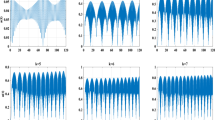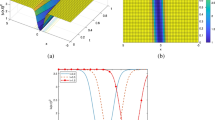Abstract
We present a simple model which allows us to predict the spectral behaviour of gain-switched Fabry-Pérot (F-P) laser diodes submitted to a weak quasi-monochromatic cw (or pulsed) injection signal. Different experiments are reported for illustration, some of them being new. The model describes the competition between the injection-driven field and the spontaneousnoise driven field during pulse build-up. The relative amplitudes of the two fields are evaluated at the gains-witching time as well as the spectral content of the injection-driven field. Different types of modal selection are found depending on the injection conditions. In the case of cw injection, there is a wide range of injection frequencies leading to single-mode emission, but two-mode lasing is also predicted for lasers exhibiting strong intrinsic chirp. These results are confirmed in experiments carried out on a 1.5 μm Fabry-Pérot laser driven by different cw dfb injection lasers. In the case of pulsed injection, the laser behaviours are similar but the model also shows the influence of the pulsed-injection arrival time on the mode selection process. This is experimentally illustrated in the case of a pulsed 1.3 μm laser operated in self-injection, the injected signal resulting from a weak spectrally-filtered optical feedback.
Résumé
Les auteurs présentent un modèle simple qui permet de prédire le comportement spectral de diodes laser Fabry-Pérot (F-P) fonctionnant en régime de commutation de gain et soumises à une injection quasi-monochromatique, de faible amplitude, continue ou impulsionnelle. Différentes expériences sont rapportées en illustration, certaines étant originales. Le modèle décrit la compétition entre le champ issu de l’injection et celui issu de l’émission spontanée lors de la construction d’impulsion. Les amplitudes des deux champs sont évaluées à l’instant de commutation de même que le contenu spectral du champ issu de l’injection. Différents types de sélection modale sont obtenues suivant les conditions d’injection. En injection continue, il existe une plage étendue de fréquences pour lesquelles l’émission est monomode, mais un comportement bimode est aussi prédit pour des lasers qui présentent une forte dérive de fréquence intrinsèque (chirp). Ces résultats sont confirmés par des expériences menées sur un laser F-P à 1,5 μm piloté par différents lasers dfb d’injection. En injection impulsionnelle, les comportements sont analogues, mais le modèle montre en outre l’influence du temps d’arrivée de l’impulsion injectée sur le processus de sélection modale. Ceci est illustré expérimentalement dans le cas d’un laser impulsionnel à 1,3 μm fonctionnant en auto-injection, l’impulsion injectée résultant d’une faible réalimentation optique filtrée spectralement.
Similar content being viewed by others
References
Liu (H. F.), Ogawa (Y.), Oshiba (S.). Generation of an extremely short single-mode pulse (2 ps) by fiber compression of a gain-switched pulse from a 1.3 μm distributed feedback laser diode.Appl. Phys. Lett. (1991),58, pp. 1284–1286.
Haus (H. A.). Theory of active mode-locking of a semiconductor laser in an external cavity.J. Appl. Phys. (1980),51, pp. 4042–4049. b) Lowery (A. J.), Onodera (N.), Tucker (R. S.). Stability and spectral behaviour of grating-controlled actively mode-locked lasers. IEEE J. QE (1991), 27, pp. 2422-2429.
Anderson (T.), Lundquist (S.), Eng (S. T.). Generation of single-mode pulses by injection-locking of an AlGaAs semiconductor laser.Appl. Phys. Lett. (1982),41, pp. 14–16.
Stelmakh (N.), Lourtioz (J. M.), Julien (F. H.). Injection-locking of a Q-switched AlGaAs laser with fast saturable absorber.Electron. Lett. (1991),27, pp. 160–162.
Cavelier (M), Stelmakh (N.), Xie (J. M.), Chusseau (L.), Kazmierski (C), Bouadma (N.). Picosecond (≥ 2.5 ps) wavelength tunable (≈ 20 nm) semiconductor laser pulses with repetition rates up to 12 GHz.Electron. Lett. (1992),28, pp. 224–226.
Bouchoule (S.), Stelmakh (N.), Cavelier (M), Lourtioz (J. M.). Highly-attenuating external cavity for picosecond tunable pulse generation from gain/Q-switched laser diodes.IEEE J. QE (1993),29, pp. 1693–1699.
Lourtioz (J. M.), Stelmakh (N.), Bouchoule (S.), Cavelier (M.), Chusseau (L.). Ultrashort tunable emission from gain/Q-switched laser diode with highly attenuating selective external cavity.18th Int. Quantum Electron. Conf., Vienna (juin 1992), paper PW099, Conf. Digest, pp. 320–321.
Schell (M), Huhse (D.), Weber (A. G.), Fischbeck (G.), Bimberg (D.), Starasov (D.), Gorbachov (A. V), Garbuzov (D. Z.). 20 nm wavelength tunable picosecond pulse generation at 1.3 μm by self-seeded gain-switched semiconductor laser.Electron. Lett. (1992),28, pp. 2154–2155.
Schell (M), Huhse (D.), Bimberg (D.). Generation of 2.5 ps light pulses with 15 nm wavelength tunability at 1.3 μm by a self-seeded gain-switched semiconductor laser.IEEE Photon. Technol. Lett. (1993),5, pp. 1267–1269.
Cassard (P.), Lourtioz (J. M). Injection-locking of high-power pulsed lasers. Part I: monochromatic injection.IEEE J. QE (1988),24, pp. 2321–2337.
Kobayashi (S.), Kimura (T.). Injection-locking in AlGaAs semiconductor laser.IEEE J. QE (1981), pp. 681–689.
Siegman (A. E.). Lasers.Univ. Science Books, Mill Valley, CA 94941, Ed.A. Kelly (1986), Chap. 7.
Yariv (A.). Optical electronics.Saunders College Publishing (1991), p. 164.
Cavelier (M). Etude des propriétés dynamiques des lasers à puits quantiques du système InGaAsP.Thèse de doctorat de l’Université Paris-Sud (1992).
Henry (C. H.). Theory of the linewidth of semiconductor lasers.IEEE J. QE (1982),18, pp. 259–264.
Tamir (T.). Guided wave optoelectronics. Springer Verlag, Springer Series in Electronics and photonics (1990), 26, Second Edition, Chap. 5, pp. 230–237.
Bouchoule (S.), Stelmakh (N.), Lourtioz (J. M), Cavelier (M.), Kazmierski (C). Phase-amplitude coupling factor of single-mode gain-switched InGaAsP laser diodes.IEEE Photon, technol. Lett. (1992),4, pp. 979–982.
Author information
Authors and Affiliations
Rights and permissions
About this article
Cite this article
Bouchoule, S., Lourtioz, JM. Injection-seeding and self-injection-seeding of gain-switched Fabry-Pérot laser diodes. Ann. Télécommun. 49, 595–606 (1994). https://doi.org/10.1007/BF03001314
Received:
Accepted:
Issue Date:
DOI: https://doi.org/10.1007/BF03001314
Key words
- Semiconductor laser
- Fabry-Pérot resonator
- Spectral properties
- Pulsed laser
- Laser mode
- Theoretical model
- Experimental result
- Injection locking




